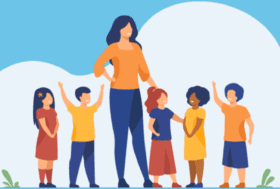How can we use wellbeing opportunities to positively impact pupils’ ability to self-regulate in a Year 3 classroom?

The enquiry question
As part of the Enquiring Schools programme, I completed an action research project on the question: ‘How can we use wellbeing opportunities to positively impact pupils’ ability to self-regulate in a Year 3 classroom?’. Enquiring Schools is a high-quality CPD programme that supports teachers to conduct a small-scale enquiry and practically engage with research evidence. Self-regulation is ‘the control of one’s behaviour through the use of self-monitoring […] self-evaluation […] and self-reinforcement’ (American Psychological Association, n.d.). Self-regulation can help with overcoming barriers to learning related to poor psychological wellbeing (Bodrova, 2005). Self-regulation was the chosen focus as there was a specific rationale not only in my class but also in the wider school community. In my class, high levels of pupil anxiety were a significant barrier to learning due to a high proportion of safeguarding and SEMH needs, which meant that several children were in crisis throughout the year and unable to attempt their learning in class. In the wider school community, wellbeing is an ongoing focus due to the repercussions of the COVID-19 pandemic.
Hypotheses
Reading into the potential positive impact of yoga and mindfulness on children’s self-regulation (Butzer et al., 2016) led me to hypothesize that, if yoga and mindfulness opportunities are introduced in brain breaks (two 10-minute breaks, one in the morning and one in the afternoon):
- children will have regular opportunities to reflect on their wellbeing
- children will have a toolkit of strategies to use when they need to self-regulate.
Further reading on classroom wellbeing spaces and trauma-informed approaches to classroom design (Thompson, 2011) led me to hypothesize that, if I create a trauma-informed classroom wellbeing area:
- children will have a space to self-regulate
- children will have appropriate resources to self-regulate.
If I provide pupil premiumAdditional funding for publicly funded schools in England to raise the attainment of disadvantaged pupils of all abilities spots to the yoga club:
- Vulnerable/disadvantaged children who need it most will have maximum exposure to wellbeing opportunities.
Method
To capture a picture of current practice, I completed the following pre-test assessments:
- A mind map for children around the question: ‘How can I help myself when I feel worried in school?’
- A survey asking teachers about current practice during brain breaks and calm corners
- Observation of the class calm corner
- Observation of the class worry box usage.
Next, I introduced the wellbeing initiatives in three ways. First, I taught the class how to use the calm corner sensibly and effectively (Thompson, 2011). The children were given a tour of the calm corner and its resources:
- Six boxes filled with evidence-informed strategies
- Comfy seats (Murphy, 2019).
- Calm corner tickets and timer (Plastino, 2019)
- A worry box (school safeguarding policy)
- A box of resources to help with emotional literacy (Harmon, 2019).
They were shown and read the poster, explaining the rules for how they could use the calm corner to help them self-regulate and be ready to learn again. For the next six weeks, I used the brain breaks to introduce the six chosen strategies from the research: meditation (Weare, 2018); movement breaks (Rashedi et al., 2021); sensory toys (Rishel et al., 2019); mindfulness colouring (Thompson, 2011); breathing exercises (Thompson, 2011) and mindfulness picture books (Christopher, 2019). I was also able to provide maximum exposure to the wellbeing initiatives to at-risk pupils by providing free places to pupil premium children in the after-school yoga club, in which we practised many of these strategies each week.
To measure the impact of these interventions, I repeated the following post-test assessments:
- Observation of the class worry box
- Observation of the class calm corner
- Repeating the mind map for children on: ‘How can I help myself when I feel worried in school?’.
I also completed an informal focus group with the identified vulnerable children to explore whether they could see a relationship between the calm corner and their ability to learn. The children were asked the following questions:
- How does the calm corner help you at school?
- What is the most helpful thing in the calm corner for you?
- Follow up question: Why is (answer to the above) the most helpful thing for you?
- How do you think the calm corner and its wellbeing activities impact your learning?
Results
The bar chart below (Figure 1) shows how frequently the children used the worry box and the calm corner, before and after the interventions.

Figure 1: Observation of worry box and calm corner usage
The bar chart below (Figure 2) shows the change in responses from the children’s mind map.

Figure 2: Self-regulation mind map results
Below are the responses to the informal focus group interview with target children:
How does the calm corner help you at school?
- ‘It makes you calm and takes your worries away. It gives you a break.’
- ‘It helps me relax.’
- ‘It helps me when I don’t feel calm or I feel worried.’
What is the most helpful thing in the calm corner for you? Follow up question: Why is X the most helpful thing for you?
- ‘The meditation videos help me calm down because it has lots of options to watch and I like having something to look at and listen to.’
- ‘I like listening to music because it’s like the wind in your face and it makes you feel free.’
- ‘I like reading because it’s like you’re still learning but you’re taking a breath and you’ve done something that’s helpful for you.’
How do you think the calm corner and its wellbeing activities impact your learning?
- ‘It can help you as it’s only three, five, six minutes and then you go back to your learning. It’s like the brain breaks, so it’s just an extra brain break. It helps you focus… You worry about something, take a breather, then go back to your work more focused.’
Findings
The findings showed a positive impact on self-regulation; there was an increase in the number of children using the calm corner and worry box, and the children self-reported a greater number of self regulation strategies. Furthermore, meditation was the most popular tool for self-regulation whereas, before the intervention, speaking to a teacher was the most popular. The targeted group of children described the calm corner as helping them to ‘relax’, ‘feel calm’, a way to have a ‘break’ and ‘take your worries away’. One child explained the link between the calm corner and their ability to learn. Additional evidence of impact was demonstrated in one child choosing to paint a picture of a breathing exercise learnt in yoga club during an art therapy session: ‘I’ve painted me with the flower, to show I can always smell the flower when I need to’.
Conclusions and recommendations
A limitation of this study is the sample size. The small sample size of 30 children from an inner city London school with a high level of SEMH needs is not necessarily representative of a typical class. However, some initial recommendations can be drawn for our setting that other practitioners may wish to consider. It appears that children are more regularly reflecting on their wellbeing, as the number of children using the calm corner and worry box increased. This suggests that children are reflecting on their feelings and choosing self-regulation strategies when needed. The mind map suggests that children have a greater, more effective toolkit of self-regulation strategies. These strategies are less reliant on adults, as the most popular response changed from ‘tell an adult’ to ‘meditation’. The focus group interview shows a specific impact on the targeted children as they explained how the calm corner helps them and why this is important for learning.
As a result of the project, we will now have a calm corner in every classroom with the researched and trialed strategies. This will include the ‘rules’ and ‘tickets’ to support appropriate usage, written in ‘Communication in Print’ for inclusivity. Each strategy will also include ‘top tips’ from the Year 3 children on how, why and when to use the strategy. Teachers have been asked to monitor the children’s appropriate usage of the strategies as well as the frequency of usage. A reflection period is planned in the Spring term of the next academic year. The Parent Teacher Association have offered to fundraise any additional strategies suggested by the children to add to the calm corners after this reflection period.
References
- American Psyhcological Association (n.d.) Available at: https://dictionary.apa.org/self-regulation (accessed 26 July 2022).
- Bodrova E and Leong D (2005) Promoting student self-regulation in learning. The Education Digest 71: 54–57.
- Butzer B et al. (2016) Implementing yoga within the school curriculum: A scientific rationale for improving social-emotional learning and positive student outcomes. Journal of Children’s Services 11(1): 3-24.
- Harmon W (2019) How to Create a Calm Down Corner in 5 Easy Steps. Available at: https://theartofeducation.edu/2019/01/21/how-to-create-a-calm-down-corner-in-5-easy-steps/ (accessed 14 June 2022).
- Rishel C et al. (2019) Trauma-Informed Elementary Schools: Evaluation of School-Based Early Intervention for Young Children. Children & Schools 41(4): 239–248.
- Murphy S (2019) Fostering mindfulness: Building skills that students need to manage their attention, emotions, and behavior in classrooms and beyond. Markham, Ontario: Pembroke Publishers.
- Plastino L (n.d.) The Classroom Calming Corner. Watson Institute. Available at: https://www.thewatsoninstitute.org/watson-life-resources/situation/classroom-calming-corner/ (accessed 14 June 2022).
- Weare K (2018) The Evidence for Mindfulness in Schools for Children and Young People. Available at: https://mindfulnessinschools.org/wp-content/uploads/2018/10/Weare-Evidence-Review-Final.pdf (accessed 14 June 2022).
- Rashedi RN et al. (2021) A Yoga Intervention for Young Children: Self-Regulation and Emotion Regulation. Journal of Child and Family Studies 30(8): 2028–2041.
- Christopher L (2019) Books for young people to encourage mental wellbeing in troubled times. Available at: https://www.booktrust.org.uk/news-and-features/features/2019/december/books-for-young-people-to-encourage-mental-wellbeing-in-troubled-times/ (accessed 14 June 2022).
- Thompson C (2021) The Impact of a Classroom Calm Down Corner in a Primary Classroom. Available at: https://nwcommons.nwciowa.edu/cgi/viewcontent.cgi?article=1304&context=education_masters (accessed 2 August 2022).










